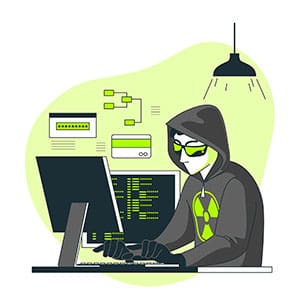[qa-schema question=”How to Secure your Website?” answer=”1. Change your passwords often and enable 2-factor authentication
2. Update Your Software
3. Review Your Current Hosting Provider
4. Use Tools Available to You to check for security issues
“]
[/faq-page]
Securing a WordPress website involves multiple steps. Here’s a basic guide to help you achieve a higher level of security: Remember, no website can ever be 100% secure, but following these steps can significantly reduce your site’s risk of being compromised.
-
Update Regularly: Keep your WordPress core, plugins, and themes updated to their latest versions. These updates often include patches for security vulnerabilities.
-
Strong Admin Credentials: Use strong, unique usernames and passwords for your WordPress admin account. Avoid usernames like “admin” or “test,” and utilize solid and complex passwords.
-
Use a Security Plugin: Numerous WordPress security plugins can help enhance your website’s security, such as Wordfence, Sucuri, iThemes Security, etc. These plugins offer a range of features, from firewalls to malware scanning and login attempt limiting.
-
Limit Login Attempts: Limiting login attempts can prevent brute-force attacks. This can usually be done through security plugins.
-
Implement Two-Factor Authentication (2FA): Adding an extra layer of security to the login process can drastically reduce the risk of unauthorized access. WordPress plugins are available that facilitate this, like Google Authenticator – WordPress or Two Factor Authentication.
-
Use SSL Certificate: An SSL (Secure Socket Layer) certificate encrypts data transmitted between your website and your users. This is crucial if you handle sensitive user data. Most web hosts offer free SSL certificates via Let’s Encrypt.
-
Change WordPress Database Prefix: By default, the WordPress database prefix is ‘wp_’. Changing this can help protect your site against SQL injection attacks.
-
Disable File Editing: WordPress allows admin users to edit PHP files of plugins and themes from the admin area. This can be disastrous if a hacker gains admin access. Add
define('DISALLOW_FILE_EDIT', true);to your wp-config.php file to disable this feature. -
Regular Backups: Regularly back up your WordPress site so you can quickly restore it in case of a ****. Many plugins provide automated backup services.
-
Secure Your wp-config.php File: The wp-config.php file holds crucial information about your WordPress installation. Protect it by moving it from one directory up from your public_html folder.
-
Set Directory Permissions Carefully: Poor file and directory permissions can be a serious security threat. Usually, directories should be 755 or 750, and files should be 644 or 640, except wp-config.php, which should be 600.
-
Disable XML-RPC if Not in Use: XML-RPC was enabled by default in WordPress 3.5 because it helps connect your site with web and mobile apps. However, if not used, it can be a security risk, as it can be used for brute force attacks. You can disable it using plugins.
-
Monitor Your Site: Keep an eye on your site’s security with tools like Google Search Console, which can alert you to malware infections, and Wordfence, which can alert you to numerous security issues.
Change your passwords often and enable 2-factor authentication
 We’re guilty of having used the same password for different sites. But if your business page’s password is the same as your Clash of Clans account, you might want to consider making them different.
We’re guilty of having used the same password for different sites. But if your business page’s password is the same as your Clash of Clans account, you might want to consider making them different.
Google suggests changing your password to include a combination of uppercase and lowercase letters, numbers, and special characters. Once you have one in mind, you can test website security by inputting a similar password into any password-strength-checking website. These are great for a free website security check; be sure not to put in your actual password.
You can also enable 2-factor authentication if that service is offered. Use your phone or a unique PIN to verify your account when you log in and add an extra layer of protection.
Update Your Software
We’ve all seen that “Update Available” message blinking on your site. It’s supposed to catch your eye and cause a feeling of immediacy, but compared to your daily workload’s demands, it’s pretty easy to ignore. However, outdated software is one of the main reasons many sites fail a website security check, leaving them open for a hacker to waltz right in.
Make sure everything that needs updates is updated regularly:
• Web server (Apache, Nginx, etc.)
• CMS
• Plugins
• Add-ons
• Any other tools you use regularly
Google also suggests removing any plugins or tools you don’t use that may be slowing down your site speed.
Review Your Current Hosting Provider
 What kind of security does your hosting provider offer? Will it support you if your site gets hacked? If not, switching to more secure website hosting committed to your needs may be time.
What kind of security does your hosting provider offer? Will it support you if your site gets hacked? If not, switching to more secure website hosting committed to your needs may be time.
If you’re hosting your server, you must be even more in tune with any possible website security issues that may come up. If you don’t wake up thinking, “Is my website secure?” each morning, you might consider moving to a dedicated hosting provider.
Use the Tools Available to You
If you aren’t using Google Search Console for your site, you should be. Search Console offers webmasters of all experience levels a way to monitor their website security. If Google detects hacked content on your site, this tool is Google’s way of letting you know.
Google’s last suggestion is self-serving, but who can blame them? They’ve created useful, powerful tools for free, so you might as well use them. It’s the closest thing we have to knowing precisely what they want to see, and if it helps you understand how to secure your website, too, then all the better.
Protect Your Site and Avoid Getting Hacked
Taking preemptive measures to deter hackers is a large part of knowing how to protect your website. Hackers are more likely to target sites with less security, so if you’re still wondering, “is my site secure?” you should watch Google’s #NoHacked series.
Some of the info in this first post is pretty basic, but it’s helpful to review. So if you’re missing these best website security tips, now is an excellent opportunity to put your site in order. But we’ve got high hopes for the future of Google’s #NoHacked campaign, and we’re eagerly awaiting the next installment.
